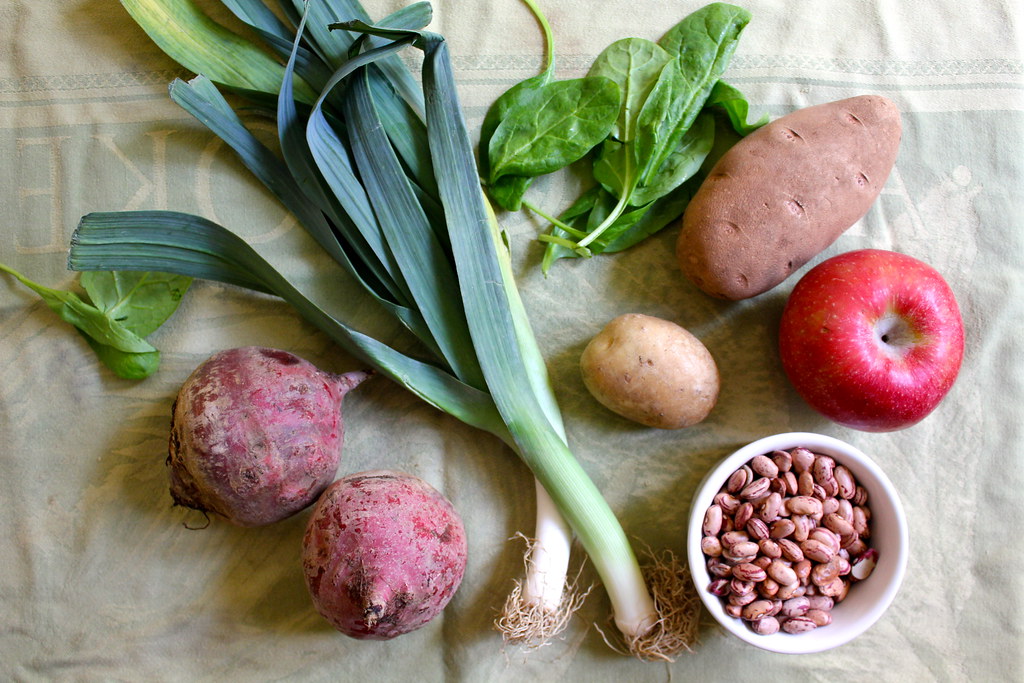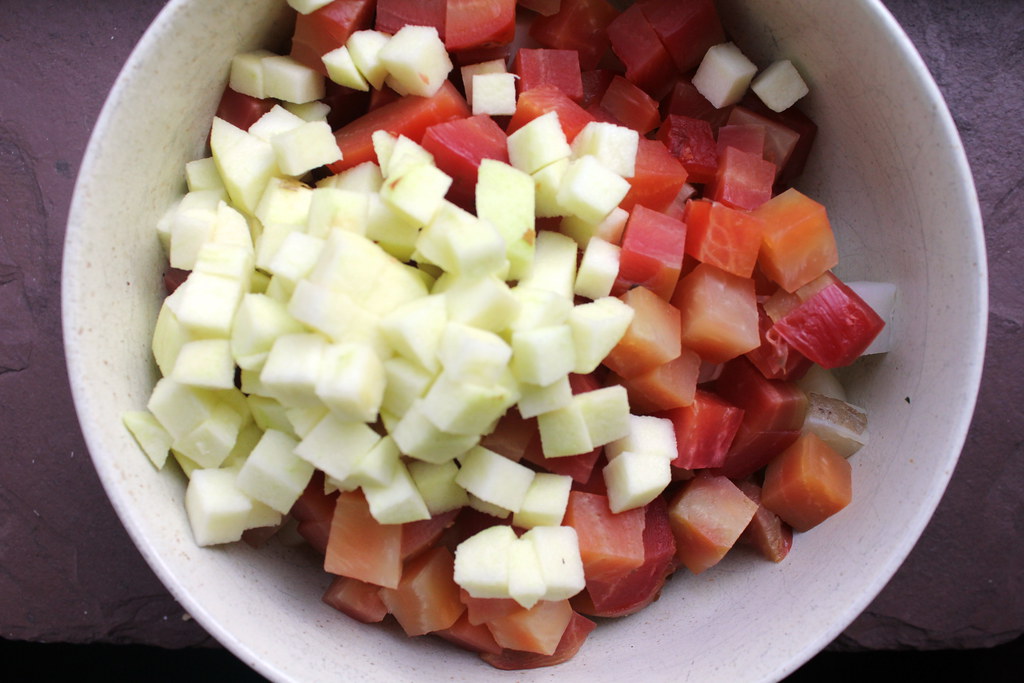What do you do with one whole week’s CSA share for a single meal? My friend Wen-Jay, who runs Local Roots CSA, decided to put me to this challenge to help kick off the winter CSA season. I was up for the challenge, but had another to contend with: what do you do with a big batch of food when you live alone and have no other mouths to feed? I eventually determined it would be a soup, and salad—preferably the kind that keeps.
I was told to use everything in the share, but not exclusively those ingredients to create a complete meal with. It sounded like a round of Iron Chef or Chopped, as I didn’t know what would be in last week’s CSA share before I received it. But my illusions of being spontaneously brilliant were shattered soon after Wen-Jay thrust the “mystery bag” into my hands, walking off into the sunset with her corgi bouncing beside her. It was a fair and well-balanced assortment of ingredients, but what was I to do with them?

My bag consisted of: baby spinach, chioggia beets, leeks, cranberry beans, apples and potatoes.
I thought of a soup, especially since the weather’s been so up and down lately and this seemed like a cozy solution. But the beets and especially those apples really threw me off. Beet-estrone? Then I realized that I had just about all the ingredients for a proper Scandinavian beet and herring salad (or sillsalad, in Swedish), with its cubed potatoes and apples along with beets bound with yogurt or sour cream.
So it was a soup and salad for a refreshing combo. That constituted a complete meal, and it was also stuff that could be saved and eaten again for more of those throughout the week.
 substituting with smoked herring fillets, or kippers
substituting with smoked herring fillets, or kippers
Instead of the wine or vinegar-pickled herring that would be classic for this dish, I had a tin of smoked herring, also known as “kippers.” I decided to go with this instead of the traditional route, but will say that a good amount of fresh lemon juice is really crucial to brighten and balance the finished result in a way that would probably be more relaxed with more acidic, pickled herring fillets. I will also say that I am not Swedish, so eating beet and herring salad is not an everyday taste for me. This is why I prepared the dish knowing full well I’d have somewhere to bring it on Sunday, for an artist’s potluck nearby.
 combining diced apples, roasted beets and boiled potatoes for the salad
combining diced apples, roasted beets and boiled potatoes for the salad
My neighbor who I’ve been delighted to become acquainted with recently, Sally Mara Sturman, holds seasonal walk-throughs of her latest artwork in her home, and this one was accompanied by a potluck dinner. I thought that a chilled beet and herring salad would be a colorful addition that probably no one else would bring to the table, and I also thought that Sally and many of her guests would be okay with preserved fish (because Sally is also a fishmonger at Blue Moon Fish, at the Greenmarket). Herring, especially once smoked, can be such a pervasive flavor that it will enhance every ingredient in this salad, but I think that’s the point of it. You use just a little bit of protein, like the preserved fish fillets, to go a long way with homey ingredients like beets, potatoes, apples and occasionally hard-boiled eggs. It’s the dressing rather than the substance, you could say. And it’s a really great way to enjoy a lot of winter ingredients, like beets. (It was nice that the heirloom beets in the CSA were a jewel-toned pink once cooked, which didn’t stain the entire salad.)
 sweating the leeks, carrot and celery for the soup
sweating the leeks, carrot and celery for the soup
So with the salad made one day ahead to marinate in its own flavors, I got started on making the soup. Really, the ingredients just sort of wrote their own recipe here. The only thing I added to the soup that wasn’t in my CSA share were carrots, celery, garlic, water and some salt and pepper. Oh and a little squeeze of tomato paste, to add vegetable-based richness to the broth.
If you like your soups a little more thick in body, then a great addition are beans. These beautifully speckled cranberry beans looked almost too good to eat, but once soaked, cooked and further softened in the pot, they melted away quite a bit to add density to the broth. Time-saving trick? Blend the soup for just a couple seconds with an immersion blender to mush up some of the ingredients, but still retain plenty of chunks.
 the finished cranberry bean and spinach soup
the finished cranberry bean and spinach soup
The soup was indeed cozy, and very practical. I’ve been eating quick and healthy lunches with it (and bread or sandwiches instead of salad) for a few days. This post is perhaps a long-winded way of saying that CSAs are not impractical. You could further that by saying that cooking–with local and seasonal ingredients from small farms, no less–can be practical, efficient, low-cost and relatively healthful as well. But that would be the takeaway of hopefully every post on this blog, too. This one just gave me some bullet-proof results. Yes, CSAs are good for you as well as the farm, I would conclude. Let’s do this more often, throughout the winters, too.
Cranberry Bean and Spinach Soup
(makes about 1 pint, or 4-6 servings)
½ cup dried cranberry beans, soaked overnight
2 tablespoons extra-virgin olive oil
2 leeks, white and light green parts only, chopped
1 medium-sized carrot, chopped
2 celery ribs, chopped
2 cloves garlic, minced
2 teaspoons tomato paste
3 cups vegetable stock (or substitute with water)
1 bay leaf
2 cups packed fresh spinach
salt and pepper to taste
Cover the beans with 4 inches of water in a pot and bring just to a boil. Reduce to a simmer and cook, covered, until the beans are tender, about 45 minutes to 1 hour.
Meanwhile, heat the olive oil in a large pot or Dutch oven. Add the leeks and a pinch of salt and cook on low heat, stirring occasionally, for 4-6 minutes. Add the carrots and celery along with another pinch of salt and continue cooking on low heat, stirring occasionally, for 6-8 minutes. Add the tomato paste and stir to combine. Add the garlic and cook another minute.
Drain the beans and add to the vegetables. Add the stock or water and bay leaf and increase heat to bring to a boil. Reduce to a simmer and cover. Cook, checking occasionally, for at least 45 minutes, preferably 1 hour. If a thicker broth is desired, blend for a few seconds with an immersion blender (or transfer a few cupfuls to a blender or food processor and pulse a few seconds). Add the spinach and let cook another 5 minutes to wilt thoroughly. Season with salt and pepper to taste.
Beet and Herring Salad with Potatoes and Apples
(makes 6-8 servings)
2 medium-sized beets
2 medium-sized potatoes
1 large apple
2-3 oz pickled or smoked herring, coarsely chopped or crumbled
juice of 2 fresh lemons
½ cup plain yogurt or sour cream
salt and pepper to taste
chopped fresh herbs, such as dill or parsley (optional)
Preheat oven to 400 degrees. Wrap each beet individually in foil and place on the oven racks. Roast for about 45 minutes, or until the beets feel tender when pressed. Let cool completely. Once cooled, the skins should be easy to slip off. (See Simply Roasted Beet recipe for more guidance.)
Halve the potatoes lengthwise and cover with water in a pot. Bring to a boil and cook until the potatoes are just tender. Drain and let cool completely.
Dice the potatoes, peeled beets, and the apple. Combine in a large bowl with the herring and season with salt, pepper and the lemon juice to taste. Taste for seasoning, adding more salt, pepper or lemon juice as desired. Stir in the yogurt or sour cream and the chopped fresh herbs, retaining some of the herbs for garnish. Serve with a sprinkle of herbs on top.
Cost Calculator
(for two dishes of 4-6 or 6-8 servings each)
beets, apples, spinach, potatoes, leeks, cranberry beans: I’m told that the vegetable share from Local Roots CSA was $14/week, and the fruit share was $8. But I used only 1 apple and was given 4 lbs of them; I also have leftover a huge bag of spinach and lots more cranberry beans. I’m guesstimating this recipe used about: $10
1 fillet herring or kippers (at $4.99/tin of 4): $1.25
½ cup plain yogurt: $0.50
1 lemons: $0.50
1 carrot: $0.25
2 celery ribs: $0.50
olive oil, salt, pepper, 2 cloves garlic: $0.25
Total: $13.25
Health Factor![]()
![]()
![]()
Three brownie points: The great thing about making meals from a varied CSA share is that you’re eating really, really healthful food. Superfoods, like spinach and beets, and heart-healthy food, like beans. Along with that, we’ve added a dab of preserved herring for some rich omega-3 and omega-6 fatty acids, which these oily fish contain so much of. All that lemon juice in the salad contributes Vitamin C, and the yogurt, probiotics. You can kind of see why some cultures basically live off of a salad like this throughout the long winters. Damn, I should have eaten more of it at that party.
Green Factor![]()
![]()
![]()
![]()
![]()
![]()
![]()
![]()
![]()
Nine maple leaves: For goodness’ sake, I don’t know why I left off one leaf. Maybe it’s the non-local lemons and olive oil. But really, this meal is incredibly good for your health and also that of the environment. Those filling beans for protein, the hardy winter vegetables that store well, and that preserved herring, which is a very plentiful, sustainable, and underappreciated (in our culture) fish. All are low-cost on the environment, and on you.

3 Responses
caralyn @ glutenfreehappytummy
looks like a hearty bowl of comfort goodness!
9 Oily Fish Recipes to Embrace Eating Lower on the Fish Food Chain |
[…] It’s not hard to understand why salads like these feature prominently in Nordic cuisines. Packed with vitamins and nutrients, they’re incredibly sustaining, perfect fare for making it through a long winter. Get the recipe here. […]
9 Oily Fish Recipes to Embrace Eating Lower on the Fish Food Chain | FYTRO SPORTS
[…] It’s not hard to understand why salads like these feature prominently in Nordic cuisines. Packed with vitamins and nutrients, they’re incredibly sustaining, perfect fare for making it through a long winter. Get the recipe here. […]